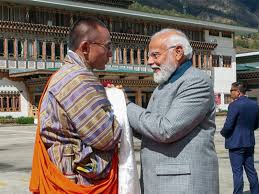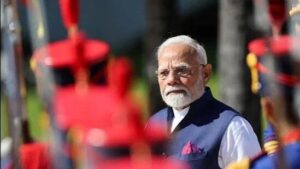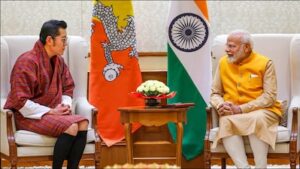Digital News Guru National Desk:
PM Modi’s Two-Day Visit to Bhutan
The Indian PM, Narendra Modi, is scheduled to undertake a two-day state visit to Bhutan from 11 to 12 November 2025, a trip that underlines the unique and strategic partnership between the two Himalayan neighbours. The visit is meant to strengthen the “special ties of friendship and cooperation” between India and Bhutan.
Objectives and Agenda of the Visit
According to the official statement by the Ministry of External Affairs (MEA) of India, the visit is designed “to strengthen the special ties of friendship and cooperation” between India and Bhutan.
Key agenda items include:
- Prime Minister Modi will receive an audience with His Majesty Jigme Khesar Namgyel Wangchuck, the King of Bhutan.
- Together, they will inaugurate the 1,020 MW Punatsangchhu‑II Hydroelectric Project — a major hydropower project jointly developed by India and Bhutan.

- Modi will meet the Bhutanese Prime Minister Tshering Tobgay for wide-ranging talks.
- Participation in Bhutan’s celebrations for the 70th birth anniversary of the former King, Jigme Singye Wangchuck.
- A spiritual dimension: the visit coincides with the exhibition of the sacred Piprahwa relics of Lord Buddha, with Modi set to offer prayers at Tashichhodzong in Thimphu and attend the Global Peace Prayer Festival organised by the Bhutanese government.
Why the Visit Matters
- Reinforcing India–Bhutan strategic ties
India and Bhutan share a long-standing and deep relationship characterised by mutual trust, strategic cooperation, and people-to-people links. The MEA underscores this as “a unique and exemplary partnership marked by deep mutual trust, goodwill and respect for each other.”
From India’s perspective, Bhutan is a key neighbour: its stability, development and connectivity are of strategic importance. For Bhutan, India remains its largest and most reliable partner in developmental, economic and infrastructural domains.
- Energy cooperation and economic linkage
Hydropower has been a cornerstone of India-Bhutan relations for decades: Bhutan’s mountainous terrain provides excellent potential for large‐scale hydro projects, much of which is either consumed domestically or exported to India.
The inauguration of the Punatsangchhu-II project — at 1,020 MW — symbolizes this cooperation moving forward. It underscores both countries’ interest in expanded energy trade, sustainable growth, and shared infrastructure.
- Connectivity and infrastructure push
While less publicly detailed in the visit’s announcement, media reports indicate that Modi’s visit will also review rail connectivity and cross‐border infrastructure initiatives linking India and Bhutan.
Improved connectivity is critical for Bhutan’s economic diversification, facilitating trade, tourism and greater integration with India’s northeast region.
- Cultural, spiritual and diplomatic overlay
The visit coincides with the Bhutanese royal anniversary celebrations and the religious event around the Piprahwa relics. These factors add a symbolic – rather than purely transactional – element, reinforcing the people-to-people and cultural dimension of the bilateral relationship. The shared Buddhist heritage and friendly ties go beyond commerce and strategy.
What to Watch
As the visit unfolds, several outcomes will be particularly noteworthy:
- MoUs and project announcements: Beyond the hydropower inauguration, any new agreements in rail, infrastructure, tourism or digital connectivity will shape the future trajectory.
- Energy export and trade details: Whether India and Bhutan clarify timelines, financing or operational details for the hydro project and other future plants.
- Connectivity initiatives: Media attention suggests that rail links (for example between Assam/West Bengal and Bhutanese towns) may be part of the agenda. These have long‐term significance for regional integration.
- Regional and global context: The visit occurs in a broader geopolitical landscape where India’s ties with its neighbours are being emphasised (often described under the “Neighbourhood First” policy). How the visit is framed could signal India’s posture in the Himalayan region vis-à-vis other regional powers.
- Bhutan’s perspective: Observers will watch how Bhutan positions the relationship — e.g., issues of sovereignty, economic diversification, and how it balances its unique identity with increasing connectivity and cooperation.
- Soft diplomacy outcomes: The extent of cultural, social, spiritual engagement (such as events tied to the king’s anniversary, religious relics) can strengthen the intangibles of the partnership.
Challenges and Considerations
While the overall tone of the visit is positive, a few underlying considerations merit attention:
- Financing and debt sustainability: Large infrastructure projects between India and Bhutan often involve significant Indian funding (grants and loans). Ensuring Bhutan’s long-term debt sustainability is vital.
- Environmental and local impacts: Hydropower and rail projects in Himalayan terrain involve ecological risks, local displacement or ecological sensitivity. Both countries would need to ensure transparent and sustainable implementation.
- Balancing external influence: As Bhutan deepens links with India, maintaining its autonomous policy and avoiding perceptions of over-dependence will be important for Bhutan’s leadership and for India’s reputation as a respectful partner.
- Regional connectivity friction: Improvements in connectivity also bring competition and regulatory complexity (customs, logistics, trade rules). Institutional preparedness will matter.

Conclusion
Prime Minister Modi’s 11-12 November 2025 visit to Bhutan is more than a routine diplomatic trip: it is a reaffirmation of a multi-dimensional partnership spanning energy, infrastructure, culture and regional strategy. The inauguration of the Punatsangchhu-II hydro project and the scheduled high-level meetings underscore tangible progress. At the same time, the spiritual and cultural aspects reflect that the India–Bhutan relationship remains grounded in shared heritage and mutual respect.
With new infrastructure investments, connectivity initiatives and a rapidly changing regional environment, the visit could mark a new chapter in India–Bhutan ties. Both countries stand to benefit: Bhutan through strengthened development and access, India via deeper integration with its northeastern frontier and strategic Himalayan partner.
In a world of shifting alliances and rising strategic competition, this two-day visit may signal that India remains committed to its neighbours, and that Bhutan continues to see India as a reliable partner — not just in the corridors of power, but in mountains, rivers, culture and everyday lives.
You May Also Read: Vande Bharat Sleeper Hits 180 km/h in High-Speed Trial









